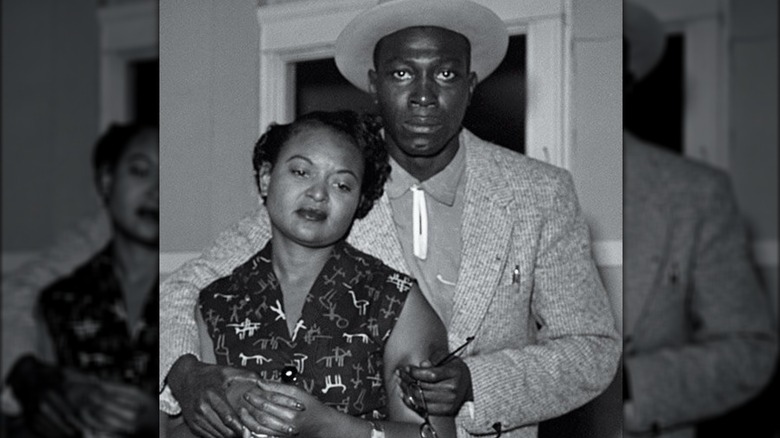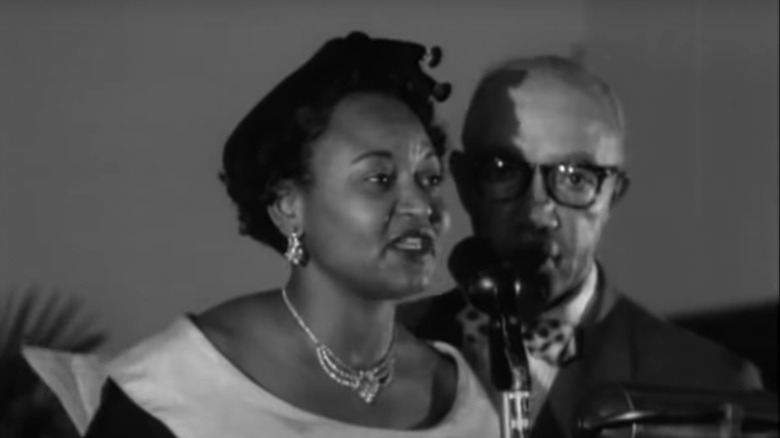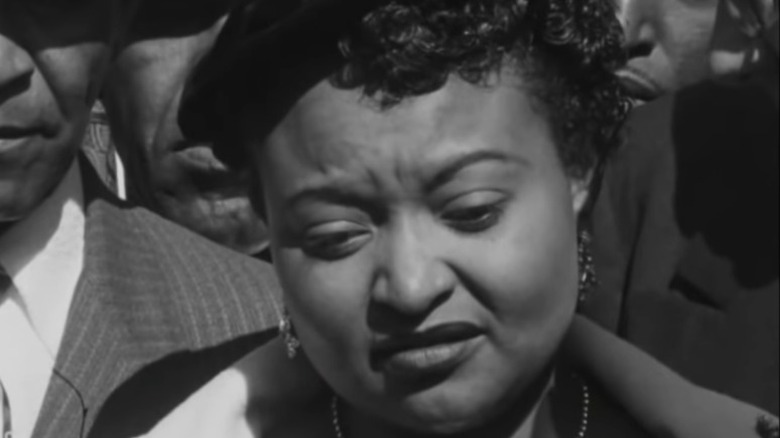Why The NAACP Refused To Work With Mamie Till After An Initial Speaking Tour
After the death of Mamie Till-Mobley on January 6, 2003 at the age of 81, she was buried at Burr Oak Cemetery in Alsip, Illinois (per Find a Grave), beneath a monument that reads: "Her pain united a nation" (via The Chicago Tribune). Nearby is the grave of her son, Emmett Till, who died almost half a century earlier, on August 28, 1955, at the age of 14.
Emmett had been sent by his mother to visit cousins in Money, Mississippi, where he was abducted, tortured, and shot dead by two white men in a racially motivated lynching. The killing — and the image of Emmett's mutilated body, which had been viewed in an open casket by an estimated 100,000 people (per The Washington Post) and shared via photographs in Jet magazine — became an incendiary moment in the history of the Civil Rights movement and a symbol of the violence and inequality Black Americans still faced, especially in the south.
Emmett Till's murder became an even greater call to arms when, a month later, his killers were acquitted by an all-white jury after deliberations of little more than an hour. In Harlem, Till-Mobley addressed a crowd of 10,000, in a demonstration organized by the hugely influential Civil Rights group the NAACP (via New-York Historical Society). "I would come to understand and appreciate them and their bravery as I learned just what was being put on the line down there in Mississippi, and how it all related to Emmett and me," Till-Mobley wrote in her memoir, "Death of Innocence."
Huge gatherings for Mamie Till
In the days that followed the acquittal of the white murderers of Emmett Till, an estimated 100,000 people turned out to protest the decision, while the NAACP planned a civil lawsuit against the killers and their accomplices, according to "Death of Innocence." At the same time, Mamie Till-Mobley formed a highly influential alliance with the NAACP to amplify public awareness of the brutality of the killing and the injustice that had subsequently been allowed to occur in the State of Mississippi.
Till-Mobley embarked on a speaking tour, talking to packed crowds at churches and community centers across the country — telling her story, describing the pressing need for change, and in the process, attracting a huge number of donations for the NAACP from her rapt audiences.
However, the alliance between the mother of Emmett Till, the grieving mother who had moved Black America with her incredible strength — even at the trial under examination from the defense, she refused to cry, lest she give any sense of weakness, according to New-York Historical Society – was sadly not to last.
The NAACP parts ways with Mamie Till
After the huge attention given to Mamie Till-Mobley's first speaking tour, the NAACP was keen to give the grieving mother of Emmett Till the platform she deserved and to leverage her story and her strength in their quest for equal rights and the elimination of racial discrimination. Her story turned countless Black Americans towards activism, while her speeches attracted "garbage cans" full of donations. In "Death of Innocence," Till-Mobley recalls that on one occasion, she saw an event organizer steal a suitcase full of money meant for the NAACP.
That day, Till-Mobley claims she was paid just $175 to speak — just under $2,000 today, according to CPI Inflation Calculator. But though it may sound as though speaking was lucrative, the fact was Till-Mobley had quit working in order to tell her son's story to anyone who would hear it. According to the New-York Historical Society, before her next speaking tour, she approached the NAACP to ask for more money for her appearances. However, the Executive Director reacted badly to her request. Till-Mobley was accused of trying cynically to line her own pockets off the back of the tragedy and the movement, and though she apologized and withdrew her request, the NAACP rescinded her invitation to embark on a second speaking tour.
She later became a teacher. Although her relationship with the NAACP ended, she remained a symbolic figure of strength in the Civil Rights movement, inspiring such activists as Rosa Parks and Martin Luther King Jr. (per PBS).


